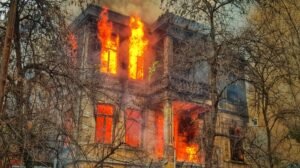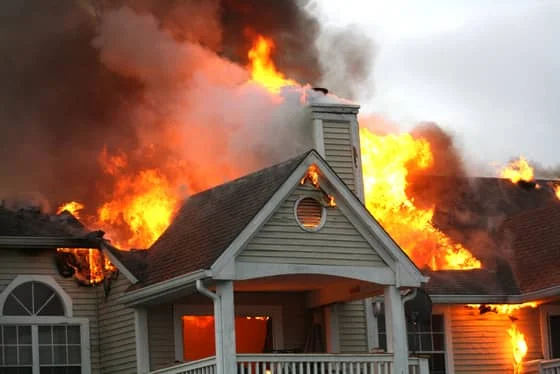Most people believe they will never experience a house fire, underestimating the odds of suffering a house fire. However, house fires happen frequently, highlighting the importance of being prepared and aware of the risks.
According to the National Fire Protection Association (NFPA), there were 361,500 home fires in the US in 2019.

The NFPA further claims that 16,600 civilians were injured and 3,700 civilians (non-firefighters) lost their lives in fires in 2019. Every two hours and 56 minutes, a structure fire in America claims the life of a person.
Depending on where you live, your risk of dying in a house fire may rise, especially in areas where the temperature of burning house tends to reach extreme levels. States with over 20 fire fatalities (excluding firefighters) and the highest fire death rates in 2019 were:
North Carolina
Alaska
Arkansas
Louisiana
Mississippi
Iowa
Tennessee
(Source: U.S. Fire Administration)
Number of Fires on the Rise
Tragically, the number of fire deaths is rising. According to the USFA, there were 20.5% more fire deaths in 2018 than there were in 2009.
The NFPA reports that the average amount of property lost due to residential fires in 2019 was $25,500 per home, an increase of 11% over the previous year. According to the USFA, since 2009, financial losses due to fires have climbed by 90.6%.
Here are some tips for fire safety
Thankfully, there are numerous actions you can take to save your loved ones and house from the destruction of fire.
Install smoke detectors first
Smoke detectors offer early warnings that can allow you and your family ample time to flee, and they have saved countless lives over the years. Nearly 3 out of every 5 home fire fatalities, according to the NFPA, happened in residences without smoke alarms or with malfunctioning smoke alarms.
On each level of your house, smoke detectors should be functional. The NFPA advises placing one smoke detector within each sleeping area and an extra one outside each sleeping area. Connect them all with wires so that if one goes off, they all do. Every ten years, replace these smoke alarms.
Additionally, the NFPA advises installing a smoke alarm in the kitchen. To reduce false alarms, it must be placed at least 10 feet away from cooking equipment.
Installing smoke detectors that also detect carbon monoxide is a good idea. This is crucial if you use a fireplace or wood burner during winter months. Not only does it ensure your safety, but it also spares you the complications associated with selling a fire-damaged house.
The U.S. Consumer Product Safety Commission (CPSC) advises changing the batteries during daylight saving time and checking the smoke detectors’ functionality once a month to ensure they’re still operational. Keep your detectors clear of dust and cobwebs to avoid false alarms.
Install fire ladders and extinguishers
All levels of your house, including the basement and garage, should have a fire extinguisher, as well as a spare in the kitchen.
Install your fire extinguishers high up on the wall, out of reach of children, but still easily accessible for adults.
Additionally, you must understand how to use your fire extinguishers. Since you won’t have enough time to learn how to use them before a fire breaks out, read the instructions and become familiar with how they work. Ask your local fire department whether they provide any instruction on how to use a fire extinguisher for homeowners.
Additionally, make an effort to get all of your fire extinguishers from the same manufacturer. When a fire breaks out, having different operating instructions for each extinguisher from several manufacturers can be perplexing.
If you need to use a fire extinguisher, keep in mind to sweep back and forth while squeezing the lever slowly and evenly toward the base of the fire.
If your house has more than one story, you should have at least two fire ladders upstairs in separate rooms in case a fire makes one area inaccessible. At least once a year, demonstrate how to set up the fire ladder to older kids so that you all know how to use it securely.
Make an escape plan
Because every second counts in the event of a fire, having a house fire escape strategy is crucial. Keep in mind that a fire can become dangerous to life in 30 seconds. Your family needs to be prepared for emergencies because the majority of fires start during the night or early morning.
Make a fire escape strategy
Drawing your home’s floor plan is the first step in creating a home fire escape plan. Map out escape routes (at least two) from the various rooms in your house.
Discuss with your family, especially the little ones, how they can get out of every area in the house. Children may have an easier time visualizing where they should flee in the event of a fire if you show them your home’s floor plan.
Choose a location outside your house where everyone will congregate. It may be a tree that is far from the physical structure of your home or a neighbor’s front porch.
Next, do a fire drill with your family to practice escaping from each room. To teach your family how to escape a fire safely, use the Fire Safe Kid instructions from the Burn Institute.
Additional tips for fleeing a fire
Learn to leave your bed a specific way. It’s advisable not to jump up as you normally do when there’s a fire. Instead, roll out of bed and make your way to the exit when the fire alarm sounds.
Remain low
The air can be as hot as 600 degrees F (315 degrees C) or even hotter at eye level, which can burn your lungs and melt your clothing, illustrating the severe odds of suffering a house fire. Although heated, the air close to the ground can be as chilly as 100 degrees F. Near the floor, the air will also be less smoky. Stay away from the smoke by getting as low to the ground as you can. Do not get up if your escape plan calls for heading downstairs. You can either down the steps on your stomach or on your hands and knees.
Learn how to safely touch doors
Use the back of your hand to lightly touch the door or the doorknob. Use your body as a bracing and open the door just a little to check for smoke if it feels chilly. If there isn’t any smoke, leave the room and follow the escape plan for your house. Close the door and exit the room through another door or window if there is smoke or a fire in the hallway.
To close the door behind you, practice
Close all of your doors when you leave your house. This may aid in halting the spread of the fire.
Assist others
Assign a member of your family to assist residents who are young children, elderly, or have mobility issues when leaving the house, considering the odds of suffering a house fire. They should leave the house and call the fire department right away if they are unable to reach them due to the fire. When there are two persons to be saved rather than just one, staying merely increases the risk for the rescuers.
Ensure that everyone is aware of 911
To report a fire, every member of your household has to know how to call 911 or the local fire department’s number.
Never go inside again
Make sure every member of your family is aware that they should never, ever return to a burning building. As soon as the firefighters arrive, let them know whether someone in your home is missing. They have the equipment and expertise necessary to accomplish rescues.
Since these are the most typical circumstances for a house fire to occur, highlighting the odds of suffering a house fire, practice fire drills in the dark with the smoke alarms activating. You can test whether the fire alarm is loud enough to wake your children by simulating a fire drill at night when they are asleep. If no adults or children are awakened by the fire alarm, designate a family member to watch after them in the event of an actual fire. At least twice a year, do a realistic fire practice to ensure that your family is always confident in their ability to escape promptly.
Have you experienced a house fire?
Eliminate the stress and frustration of repairing a property damaged by fire by selling your fire-damaged house to We Buy Fire Damaged Houses. We pay a great price and all in cash so you can move on with your life quickly. Fill out the form below to see if your home qualifies for a free quote.
Photo by Chris Karidis on Unsplash

